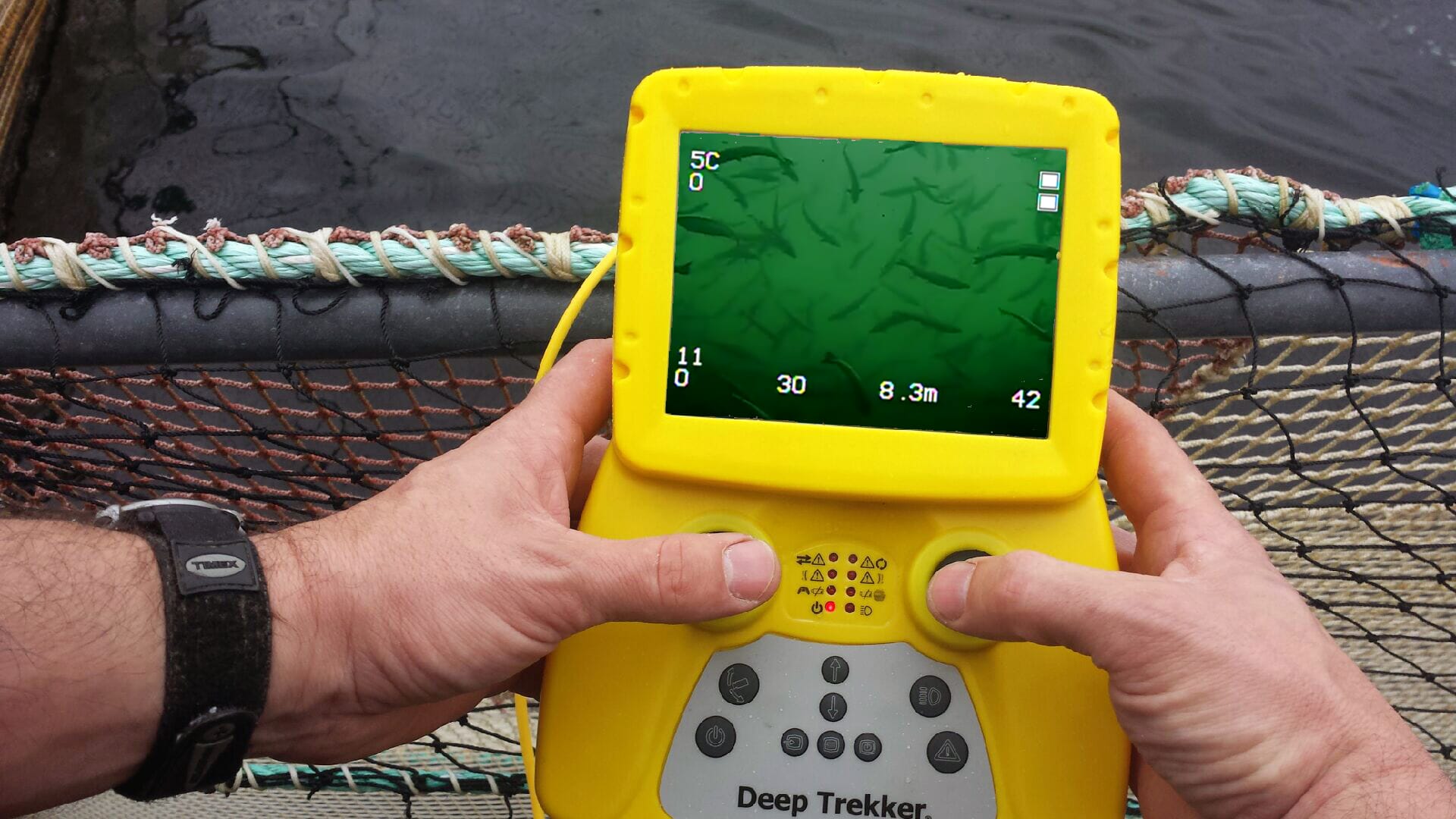ROVs provide immediate inspection solutions so farm operators and aquaculture specialists always have an understanding of their submerged infrastructure and fish stocks. The idea for the DTG2 ROV came about when Deep Trekker President Sam Macdonald dropped her flashlight in Lake Huron and began wishing that she had a tool that everyone could use to retrieve such items. Soon after she met with co-founder and engineer, Jeff Lotz, who had developed the first Deep Trekker ROV prototype for a college project at Conestoga College in Ontario, Canada. They made some improvements and threw up an ad-hoc website that led to their first sale back in 2011 to a Norwegian fish farm looking for an underwater inspection tool.
With more focus on successful and sustainable fish farming operations, the need to regularly inspect fish health and behaviour, submerged infrastructure and the underwater environment is becoming increasingly important.

Traditionally, specialist divers would do these but often at a considerable cost, while some underwater tasks are extremely dangerous. Hiring specialist divers also leaves a gap between what's going on underwater and the knowledge of farm employees working above the water. While a person may have worked on a farm for many years, if they have never seen the farm from underwater, they have really only seen about 10% of it.
In light of this, fish farmers have been turning to innovative marine technologies to keep an eye on their underwater infrastructure. Deep Trekker's ROVs allow them to do this without resorting to specialist divers, by making it possible to quickly inspect and monitor areas such as damage to nets or fish health.
"Our units are 100% portable and run on batteries that last between six to eight hours on a single 1.5 hour charge," explained MacDonald. "Everything you need to use them is contained in 1 or 2 carry cases and can be deployed in less than 3 minutes. This is ideal for aquaculture as there is no need to drag heavy equipment around a farm and there is no voltage running through the tether and water. The ROVs are battery powered so there are no risks of generator leaks."
The ROVs work as follows: the footage they capture travels up a single tether to a game-pad style controller with a viewing screen. The controller allows farmers to pilot the ROV around the water so they can see what it sees, and can access all areas including the bottom of a farm. Remote control technology means quick and more accurate assessments of fish and equipment, and a more cost effective management. The outer shell and thrusters rotate while gravity holds down an internal semi-circle weighted frame, so the main thrusters are able to rotate 180 degrees. This allows the ROVs to drive straight up and down, from side to side, and forwards and backwards with only two thrusters. A grabber arm retrieves lost objects or nets and there is also a mort pusher that can retrieve morts at the bottom of the nets.

The units are proving invaluable to the aquaculture industry as they give farmers information on what is happening underwater, such as how deep nets or cages actually are, how fish school and whether feeding machines are working properly. As they are deployed in under 3 minutes, they play a vital role in the daily inspection of nets, predator nets and mooring lines and any damage can be found quickly. They are also used for benthic surveys during site selection processes. Once a farm is up and running, regular surveys and testing with sediment and water samplers are also possible, while the surveys can be recorded as proof that the environment underwater is being regularly monitored. Fish behaviour, one of the biggest indicators of whether something is wrong with stocks, can also be checked each day. Finding problems sooner rather than later helps farmers save time and money, as they can find out immediately if something needs to be fixed.
The ROVs comes with light options and auxiliary cameras that provide detailed visual information and evidence of a healthy underwater environment. Deep Trekker is now working to develop a new net repair system, which will temporarily fix nets until farmers can bring divers in to repair them permanently.
"We have received extremely positive feedback from many farms," said MacDonald. "The first ROV that we sold was to a fish farm in Norway back in 2011. Since then, we've been keeping contact with a lot of our farm customers to ensure that we continue to deliver products and add-ons that will be helpful, and solve some of the problems farmers often face. The community has been amazing and the feedback even better."
Visitors at this year's Aquaculture UK in Aviemore, Scotland, were able to see the ROVs for themselves when demonstrations were held for fish farmers and other potential users. Industry specific add-ons, including the mort pusher and net repairer device, were also showcased. In addition to the net repairer project, Deep Trekker is conducting more research based on customer feedback to further improve its system. The company will also be attending AquaSur in Chile this year and Aquaculture Canada in Newfoundland, where more live demonstrations will be provided.
"Deep Trekker works with farms in the aquaculture industry to help solve problems we face, such as taking effective sediment samples and patching nets," explained a representative of Aqua-Cage Fisheries, a Canadian fish farm which has acquired Deep Trekker's ROV. "The ROV is cheaper, safer and more functional than divers, with a dependable and better service. We'll be continuing to use it for all our future sub-surface inspections."
To learn more about Deep Trekker's ROVs, visit https://www.deeptrekker.com/aquaculture/ or contact: sales@deeptrekker.com



